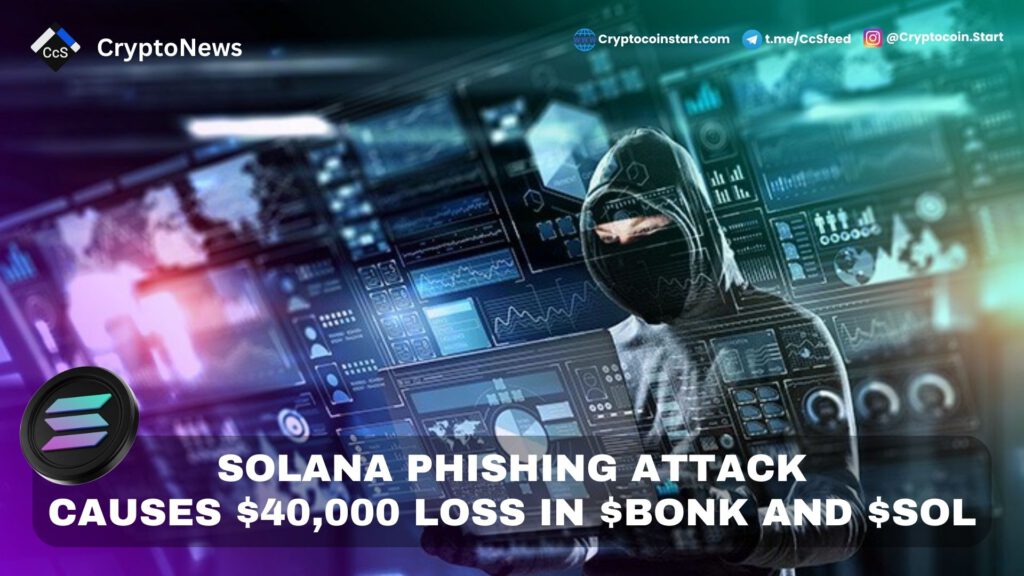
How the Phishing Attack Compromised the Wallet
According to Scam Sniffer, the phishing attack exploited a vulnerability in Solana’s transaction signing process. The attacker initiated the phishing scheme by sending the victim a seemingly standard request for signature approval. Unaware of the malicious intent behind the request, the victim proceeded to sign, unknowingly granting the attacker control over their wallet. This malicious act allowed the attacker to drain the user’s assets, including $SOL and $BONK tokens.
In Solana’s blockchain network, an attacker can gain unauthorized control over a user’s assets if the user unknowingly signs a fraudulent transaction or grants access permissions. This incident highlights the importance for Solana users to understand the risks associated with transaction signatures and access requests.
Solana’s Block Speed and Security Risks
One of Solana’s defining characteristics is its swift block speed, which significantly boosts network efficiency and transaction speed. However, Scam Sniffer pointed out that this rapid transaction pace can introduce risks, particularly in the context of phishing attacks. The platform explained that Solana’s block speed can create a gap between the on-chain state (the real-time blockchain data) and the wallet simulation state (the representation of data within a user’s wallet).
This discrepancy between on-chain data and wallet simulations can be exploited by attackers who use phishing methods to manipulate users into granting unauthorized access. Solana’s high-speed transactions can leave users vulnerable to fraud if they inadvertently sign a transaction during a phishing attempt.
Preventing Phishing Attacks on Solana: Tips from Scam Sniffer
Scam Sniffer recommends that Solana users implement several precautionary measures to avoid falling victim to phishing attacks:
- Scrutinize Access Requests: Users should carefully review any access request from applications or websites, particularly those from unfamiliar or suspicious sources.
- Double-Check Transaction Details: Before signing any transaction or access request, users should double-check the information and ensure it is from a trusted source.
- Verify Website Authenticity: Scam Sniffer urges Solana users to confirm the legitimacy of websites and applications that request access to their wallets, as phishing attacks often originate from compromised or fake platforms.
- Avoid Signing from Unfamiliar Sources: Users are encouraged to refrain from signing any requests originating from sources that are not recognized or seem suspicious.
Recurring Phishing Attack Vector in Solana
This recent phishing attack on a Solana user is not an isolated case. According to Scam Sniffer, similar attacks have occurred in the past, exploiting the differences between the on-chain and wallet simulation states. These phishing attempts leverage Solana’s network speed and efficiency to manipulate users into unknowingly granting access to their wallets.
The recurrence of this attack vector highlights the need for ongoing security vigilance within the Solana ecosystem. Scam Sniffer advises users to adopt defensive strategies and remain cautious when handling access requests or transaction signatures to minimize their exposure to phishing attacks.
How to Secure Your Solana Wallet Against Phishing Attacks
Solana users can follow these best practices to secure their wallets against phishing attempts:
- Use Reputable Wallet Providers: Ensure you are using a well-established wallet provider with a reputation for security.
- Enable Security Features: Many wallet providers offer enhanced security features, such as two-factor authentication, to provide an additional layer of protection.
- Stay Updated on Security Risks: Follow reliable sources, such as Scam Sniffer, to stay informed about the latest security threats and preventive measures.
- Disconnect from Unused Applications: Regularly disconnect from any applications or websites that you no longer use to reduce potential access points for attackers.
By following these practices, users can strengthen their security measures and reduce the risk of falling victim to phishing schemes in the Solana ecosystem.
Conclusion: Staying Vigilant in the Face of Evolving Phishing Threats
The recent phishing attack that drained $40,000 from a Solana user’s wallet serves as a stark reminder of the vulnerabilities within blockchain networks. Solana users are advised to stay vigilant, scrutinize every transaction request, and leverage available security tools to safeguard their assets.
As phishing tactics continue to evolve, platforms like Scam Sniffer play a critical role in raising awareness and guiding users on preventive measures. Solana’s unique attributes, while beneficial, may sometimes create potential entry points for attackers, making caution essential when signing transactions or authorizing access requests.
By understanding the risks and adopting security best practices, Solana users can help protect themselves and contribute to a safer, more secure blockchain ecosystem.

